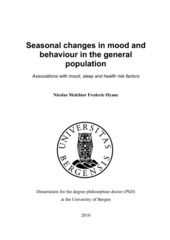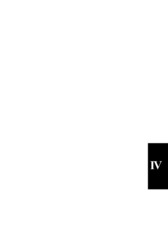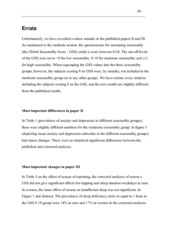| dc.contributor.author | Øyane, Nicolas Melchior Frederic | en_US |
| dc.date.accessioned | 2010-09-03T08:07:00Z | |
| dc.date.available | 2010-09-03T08:07:00Z | |
| dc.date.issued | 2010-09-10 | eng |
| dc.identifier.isbn | 978-82-308-1575-5 (print version) | en_US |
| dc.identifier.uri | https://hdl.handle.net/1956/4081 | |
| dc.description.abstract | The way seasons affect humans varies considerably between individuals, nevertheless most humans’ mood and behaviour change throughout the year. Almost 25 years ago, Seasonal Affective Disorder was described as recurring major depressive episodes during a certain time of the year. Seasonal Affective Disorder has been reported to be associated with hypersomnia, increased appetite and carbohydrate craving, and the disorder is most common in subjects with high education and socioeconomic status. However, some subjects report a high degree of seasonal changes in mood and behaviour (seasonality) without fulfilling diagnostic criteria for depression. The aim of this thesis was to characterize these subjects with respect to demographic factors, anxiety, depression, sleep and general health risk factors. We analyzed data from a large health survey, the Hordaland Health Study (HUSK). Invitation letters were sent to all men and women aged 40-44 years in Hordaland County, Norway (n=29.400), and the attendance rates were 57% among men and 70% among women. Subjects were asked to fill in the Global Seasonality Score Questionnaire, measuring seasonality on a 6-item scale. Additionally, they completed questionnaires on demographic characteristics, general health, anxiety/depression and sleep. They underwent an examination where weight, height, waist/hip circumference, blood pressure, blood glucose and blood lipid levels were measured. We found high degree of seasonality to be associated with female gender, low educational level, low annual income and being single. Furthermore, high seasonality per se was significantly correlated to anxiety, depression and sleep problems (mainly associated with insomnia). Subjects with high seasonality also had more health risk factors than subjects with low seasonality. In conclusion, high seasonality did not share the same characteristics as seasonal affective disorder, and seasonality in itself could be a risk factor for both anxiety and depression. Our results could therefore justify seasonality to be a separate dimensional trait associated with several diseases, including depression. | en_US |
| dc.language.iso | eng | eng |
| dc.publisher | The University of Bergen | eng |
| dc.relation.haspart | Paper I: European Journal of Epidemiology 20(11), Øyane, N. M.; Holsten, F.; Ursin, R.; Pallesen, S.; Bjorvatn, B., Seasonal changes in mood and behaviour associated with gender, annual income and education: The Hordaland Health Study, pp. 929-937. Copyright 2005 Springer. Full text not available in BORA due to publisher restrictions. The published version is available at: <a href="http://dx.doi.org/10.1007/s10654-005-2952-0" target="_blank"> http://dx.doi.org/10.1007/s10654-005-2952-0</a> | en_US |
| dc.relation.haspart | Paper II: Journal of Affective Disorders 105(1;3), Øyane, N. M.; Bjelland, I.; Pallesen, S.; Holsten, F.; Bjorvatn, B., Seasonality is associated with anxiety and depression: The Hordaland Health Study, pp. 147-155. Copyright 2007 Elsevier. Full text not available in BORA due to publisher restrictions. The published version is available at: <a href="http://dx.doi.org/10.1016/j.jad.2007.05.002" target="_blank"> http://dx.doi.org/10.1016/j.jad.2007.05.002</a> | en_US |
| dc.relation.haspart | Paper III: Journal of Sleep Research 17(1), Øyane, N. M.; Ursin, R.; Pallesen, S.; Holsten, F.; Bjorvatn, B., Self-reported seasonality is associated with complaints of sleep problems and deficient sleep duration: The Hordaland Health Study, pp. 63-72. Copyright 2008 European Sleep Research Society. Full text not available in BORA due to publisher restrictions. The published version is available at: <a href="http://dx.doi.org/10.1111/j.1365-2869.2008.00628.x" target="_blank"> http://dx.doi.org/10.1111/j.1365-2869.2008.00628.x</a> | en_US |
| dc.relation.haspart | Paper IV: PLoS ONE 5(3), Øyane, N. M.; Ursin, R.; Pallesen, S.; Holsten, F.; Bjorvatn, B., Increased health risk in subjects with high self-reported seasonality, e9498. Copyright 2010 Øyane et al. Reproduced with permission. Published version. The published version is also available at: <a href="http://dx.doi.org/10.1371/journal.pone.0009498" target="_blank">http://dx.doi.org/10.1371/journal.pone.0009498</a> | en_US |
| dc.title | Seasonal changes in mood and behaviour in the general population. Associations with mood, sleep and health risk factors | en_US |
| dc.type | Doctoral thesis | |
| dc.rights.holder | Copyright the author. All rights reserved | |
| dc.rights.holder | The author | |
| dc.subject.nsi | VDP::Medisinske Fag: 700::Klinisk medisinske fag: 750 | nob |



